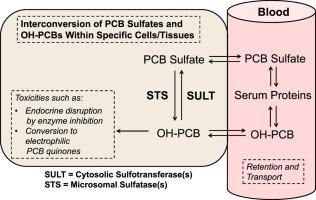Environmental Toxicology and Pharmacology ( IF 4.2 ) Pub Date : 2021-10-22 , DOI: 10.1016/j.etap.2021.103757 Michael W Duffel 1 , Kristopher Tuttle 1 , Hans-Joachim Lehmler 2 , Larry W Robertson 2

|
Polychlorinated biphenyls (PCBs) are persistent environmental contaminants that continue to be of concern due to their varied toxicities. Upon human exposure, many PCBs with lower numbers of chlorine atoms are metabolized to hydroxylated derivatives (OH-PCBs), and cytosolic sulfotransferases can subsequently catalyze the formation of PCB sulfates. Recent studies have indicated that PCB sulfates bind reversibly with a high affinity to human serum proteins, and that they are also taken up by cells and tissues. Since PCB sulfates might be hydrolyzed to the more toxic OH-PCBs, we have investigated the ability of human hepatic microsomal sulfatase to catalyze this reaction. Twelve congeners of PCB sulfates were substrates for the microsomal sulfatase with catalytic rates exceeding that of dehydroepiandrosterone sulfate as a comparison substrate for steroid sulfatase (STS). These results are consistent with an intracellular mechanism for sulfation and de-sulfation that may contribute to retention and increased time of exposure to OH-PCBs.
中文翻译:

人肝微粒体硫酸酯酶催化多氯联苯硫酸盐的水解:保留羟基化 PCB 的潜在机制
多氯联苯 (PCB) 是一种持久性环境污染物,因其不同的毒性而持续受到关注。人体接触后,许多氯原子数量较少的 PCB 会代谢为羟基化衍生物 (OH-PCB),而胞质磺基转移酶随后可催化 PCB 硫酸盐的形成。最近的研究表明,多氯联苯硫酸盐与人血清蛋白具有高亲和力可逆结合,并且它们也被细胞和组织吸收。由于 PCB 硫酸盐可能会水解成毒性更强的 OH-PCB,因此我们研究了人肝微粒体硫酸酯酶催化该反应的能力。 PCB硫酸盐的12种同源物是微粒体硫酸酯酶的底物,其催化速率超过作为类固醇硫酸酯酶(STS)的比较底物的硫酸脱氢表雄酮。这些结果与硫酸化和脱硫酸化的细胞内机制一致,可能有助于保留和增加接触 OH-PCB 的时间。











































 京公网安备 11010802027423号
京公网安备 11010802027423号